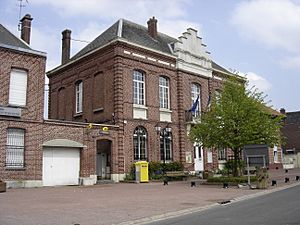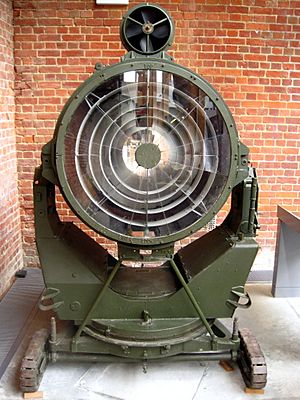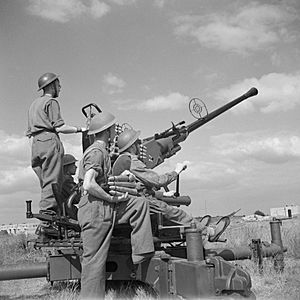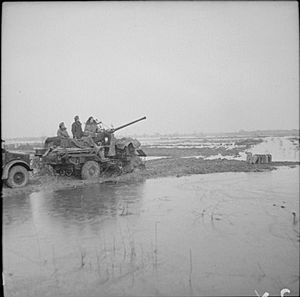1st Lanarkshire Rifle Volunteers facts for kids
Quick facts for kids 1st Lanarkshire Rifle Volunteers5th Bn Cameronians (Scottish Rifles) 56th (5th Cameronians) S/L Regiment, RA 125th (Cameronians) Light AA Regiment, RA 591 (Cameronians) LAA/SL Regiment, RA 445 (Cameronians) LAA Regiment, RA |
|
|---|---|
| Active | 1859–1967 |
| Country | |
| Branch | |
| Role | Infantry Air Defence |
| Part of | Scottish Rifles Brigade 19th Brigade 52 LAA Brigade 76 AA Brigade |
| Garrison/HQ | Glasgow |
| Engagements | Second Boer War World War I: |
The 1st Lanarkshire Rifle Volunteers was a Scottish volunteer unit of the British Army. It started in Glasgow in 1859. Later, it became a part of the Cameronians (Scottish Rifles) regiment. During World War I, the unit fought on the Western Front and in Ireland. Before World War II, it changed into an anti-aircraft (AA) regiment. It helped defend against air attacks during The Blitz and in the campaign in North West Europe. The unit continued its air defence role until 1955.
Contents
Forming the Volunteers
In 1859, people in Britain worried about a possible invasion. This led to the creation of the Volunteer Movement. Many local Rifle Volunteer Corps (RVCs) were formed. The 1st Lanarkshire (or Glasgow 1st Western) Rifle Volunteer Corps held its first drill in Glasgow on 27 July 1859. It was accepted as a military unit on 24 September 1859. Sir Archibald Campbell of Succoth, 3rd Baronet, was its first Captain. The unit paid for itself, with members covering all costs.
In February 1860, the 1st Lanarkshire RVC grew by joining with several smaller RVCs from Glasgow. Sir Archibald Campbell became the Lieutenant-Colonel Commandant. By June 1860, the unit was so large it was split into two battalions. These battalions included companies formed by bankers, lawyers, university students, and employees from various Glasgow businesses. For example, the 9th Company was made up of students and professors from Glasgow University. A future Prime Minister, Henry Campbell-Bannerman, was also a lieutenant in one of these companies.
After Sir Archibald Campbell passed away in 1866, his brother, Sir George Campbell, 4th Baronet, took over as commander. The unit moved its headquarters several times, eventually settling at 242 West George Street.
Joining the Cameronians
In 1881, the British Army made big changes to how its units were organized. The 1st Lanarkshire RVC became the main Volunteer Battalion of the new Cameronians (Scottish Rifles) regiment. It kept its original name.
The unit sent 102 volunteers to fight in the Second Boer War in South Africa. For their service, they earned their first battle honour: South Africa 1900–02.
In 1902, the four Volunteer Battalions of the Cameronians, including the 1st Lanarkshires, formed the Scottish Rifles Brigade. The High School of Glasgow also formed a Cadet Corps that joined the 1st Lanarkshires.
Becoming the Territorial Force
In 1908, the Volunteer Force became the new Territorial Force (TF). The battalion was renamed the 5th Battalion, Cameronians (Scottish Rifles). The University Company became part of the Officers' Training Corps (OTC), which trains future officers. The High School Cadet Corps also joined the OTC. The 5th Battalion was part of the Lowland Division of the TF.
World War I Service
Mobilization and Training
When World War I began in August 1914, the Lowland Division was at its annual training camp. The 5th Scottish Rifles quickly gathered at their headquarters in Glasgow. They were tasked with guarding important places around Glasgow and the River Clyde. The unit was ready for war by 10 August and moved to defend the Forth area.
Many soldiers volunteered to serve overseas. To replace them and train new recruits, a second unit, called the 2nd Line, was formed. This became the 2/5th Scottish Rifles. A third unit, the 3/5th Scottish Rifles, was also created for training.
Fighting on the Western Front
The 1/5th Scottish Rifles was one of the first TF units sent to France. They arrived in November 1914 and joined the 19th Brigade. They soon experienced trench warfare.
In September 1915, the battalion was part of the Battle of Loos. Their attack was difficult because of poison gas blowing back on them and German defenses. The 1/5th Scottish Rifles, in reserve, did not have to go "over the top" in this battle.
On 29 May 1916, the 1/5th Scottish Rifles combined with the 6th Scottish Rifles to form the 5th/6th Battalion. This new battalion joined the 33rd Division.
The Somme Offensive
The 33rd Division, including the 5th/6th Scottish Rifles, first saw major action during the Somme Offensive in July 1916. They fought in the Battle of High Wood. On 20 July, the 5th/6th Scottish Rifles attacked High Wood. They faced strong German machine gun fire and suffered many casualties. Despite heavy fighting, they managed to hold parts of the wood. The division was relieved in early August and again at the end of September for rest.
In October, they returned to the Somme sector. They attacked 'Hazy' Trench and took the 'Gun Pits' in difficult conditions, with thick mud making it hard to move supplies.
Arras and Ypres
In March 1917, the 33rd Division prepared for the Arras offensive. They helped other divisions and faced heavy fighting in the Hindenburg Line. Casualties were high.
Later that year, the division moved to Ypres Salient to join the Third Ypres Offensive. On 26 September, they were supposed to attack, but were heavily attacked themselves the day before. Despite losses, they still took part in the Battle of Polygon Wood, recapturing their original line. They then defended the muddy Passchendaele Salient during the winter.
German Spring Offensive
The German Army launched a huge attack, the German spring offensive, on 21 March 1918. The 33rd Division was sent south to reinforce the lines. When the Germans broke through further north in the Battle of the Lys, the division moved to protect Hazebrouck. On 12 April, the 5th/6th Scottish Rifles arrived to stabilize the front line near Méteren. They helped hold the line against strong German attacks for several days.
On 8 May, the Germans attacked again near Dickebusch Lake. The 5th/6th Scottish Rifles were ordered to recapture Ridge Wood. Their commander, Lt-Col H.B. Spens, led a brave counter-attack that successfully took back the wood.
The Hundred Days Offensive
After a period of rest and training, the 33rd Division returned to the front during the Allied Hundred Days Offensive. On 21 September, they made a difficult attack on the outer defenses of the Hindenburg Line. The 5th/6th Scottish Rifles faced heavy machine gun fire and were pushed back. However, their second-in-command, Major C.C. Scott, led a successful surprise attack that night, capturing 'Gloucester Road' trench and 'Meath Post'.
On 5 October, the 33rd Division crossed the Canal de Saint-Quentin without resistance. On 8 October, the 5th/6th Scottish Rifles cleared the village of Clary as the division advanced quickly. They reached the River Selle, another German defense line, on 11 October.
The division launched a major attack across the Selle River on 23 October. The 5th/6th Scottish Rifles led the attack, overcoming German defenses and reaching their objectives. They continued to advance, reaching the edge of Englefontaine. The village was captured on the night of 25 October.
The final major attack of the war for the British was the Battle of the Sambre on 4 November. The 33rd Division made rapid progress, crossing the Sambre River. By 7 November, the 5th/6th Scottish Rifles had reached the Maubeuge–Avesnes road.
The war ended with the Armistice with Germany on 11 November 1918. The 33rd Division had suffered many casualties and was also affected by the Spanish flu pandemic. The soldiers were sent home, and the 5th/6th Scottish Rifles unit was officially disbanded on 18 November 1919.
Service in Ireland
The 2/5th Scottish Rifles, the 2nd Line battalion, was formed in Glasgow in September 1914. It was part of the 65th (2nd Lowland) Division. This unit helped train new soldiers and supplied replacements for the 1st Line battalion fighting overseas. In January 1917, the 65th Division moved to Ireland. The 2/5th Battalion was stationed in places like Moore Park and Galway. It was disbanded in Tralee on 15 May 1918.
Between the World Wars
The Territorial Force was reformed in 1920. The 5th Cameronians unit was re-established in Glasgow. In 1921, it became the Territorial Army (TA). The 5th Battalion then joined with the 8th Cameronians, becoming the 5th/8th Battalion The Cameronians (Scottish Rifles). It was part of the 52nd (Lowland) Division.
Becoming an Anti-Aircraft Unit
In the 1930s, Britain needed better air defenses for its cities. Many TA infantry battalions, including the 5th/8th Cameronians, were changed into anti-aircraft (AA) units. In late 1938, the 5th/8th Cameronians became a Royal Artillery searchlight (S/L) regiment. Because the TA was growing, two regiments were formed:
- 5th Bn Cameronians (Scottish Rifles) (56th Searchlight Regiment)
- 8th Bn Cameronians (Scottish Rifles) (57th Searchlight Regiment)
The 56th Searchlight Regiment had three searchlight batteries.
World War II Service
Mobilization and The Blitz
The 56th S/L Regiment was part of the 3rd AA Division, which protected Scotland. In August 1939, just before World War II started, all AA units were fully prepared for war. The 56th S/L Regiment became part of the 52nd Light Anti-Aircraft Brigade.
In August 1940, all searchlight regiments joined the Royal Artillery. The unit was renamed 56th (5th Battalion, Cameronian Scottish Rifles) Searchlight Regiment, RA. During The Blitz (heavy German air raids), eastern Scotland, including the Edinburgh area, was not hit as hard as other parts of Britain.
In January 1942, 535 S/L Battery left the regiment and joined the 57th (8th Cameronian) S/L Regiment. It was replaced by 357 S/L Battery.
Becoming a Light Anti-Aircraft Regiment
By 1942, the British Army had enough searchlight units but needed more light anti-aircraft (LAA) gun units. So, on 18 February, the 56th S/L Regiment was changed into an LAA unit, becoming the 125th (Cameronians) LAA Rgt. It now had LAA batteries instead of searchlight batteries.
By June, the regiment was ready and moved to South East England. In spring 1943, the 125th LAA Rgt joined the 76 AA Brigade. This brigade was preparing for the invasion of Normandy (Operation Overlord). The regiment trained intensively, practicing with landing craft and preparing its Bofors 40 mm guns.
Normandy Campaign
Elements of the 76 AA Brigade landed on D-Day (6 June 1944). The 125th LAA Regiment's headquarters landed in Normandy on the evening of 9 June. Its batteries were ready for action by mid-June, defending Gold Beach, the Mulberry Harbour at Arromanches, and the harbor of Port-en-Bessin. They engaged German bombers at night and fighter-bombers during the day.
After the Battle of Falaise, the regiment moved forward. On 27 August, 419 LAA Battery received Self-Propelled (SP) Bofors guns, which could move with the advancing army. On 1 September, it helped cover the crossing of the Seine River. The regiment later moved to support the Siege of Boulogne and then the Siege of Dunkirk, using its guns against both aircraft and ground targets.
Defending Antwerp
On 1 November, the regiment moved to Antwerp to defend the vital port and the Scheldt estuary. They set up gun positions along the waterway. On 1 January 1945, the German air force launched Operation Bodenplatte, a large daylight attack on Allied airfields. The 76th AA Brigade, including the 125th LAA Regiment, shot down many enemy aircraft.
Antwerp was also heavily attacked by V-1 flying bombs. One V-1 landed in 417 LAA Battery's area, causing casualties. As the war in Europe ended, the regiment remained in the 76th AA Brigade. They stopped firing on 3 May 1945, when a truce allowed supplies to reach civilians in Holland. The war in Europe ended on 8 May (VE Day).
Post-War Occupation
After VE Day, the 125th LAA Regiment moved into Germany in June to help control the Dortmund–Bochum area. They guarded important places and managed camps for former German soldiers and displaced people. As soldiers were sent home, units were gradually disbanded. The 125th (Cameronians) LAA Regiment was officially put into "suspended animation" (meaning it stopped existing but could be reformed) on 1 March 1946.
After the War
When the Territorial Army was reformed on 1 January 1947, the regiment was re-established in Glasgow as the 591st LAA Rgt (Cameronians). It was part of the 77 AA Brigade. In 1949, it became the 591st (Mixed) LAA/SL Rgt (Cameronians), meaning it included members of the Women's Royal Army Corps. In 1950, it absorbed another Glasgow LAA/SL regiment.
On 10 March 1955, AA Command was disbanded, and many units merged. The 591st (Cameronians) LAA Rgt combined with two other regiments to form the 445th (Cameronians) LAA Rgt. This new regiment had three batteries: P (Cameronians) Bty, Q (Blythswood) Bty, and R (Glasgow) Bty.
In 1961, the 445th LAA Rgt absorbed another battery and was renamed the 445th (Lowland) LAA Rgt. It later became a Light Air Defence Regiment. In 1967, when the TA was reorganized, the regiment was disbanded. Its members became part of other Royal Artillery units.
Uniforms and Badges
When the unit first formed in 1859–60, the companies wore different grey uniforms. In 1862, they all agreed to wear 'Elcho grey' (a type of grey) with blue details. They had blue collars and cuffs with grey lacing, and blue stripes on their trousers. Their soft grey peaked cap had a blue-and-white checkered band and a silver bugle badge.
Over the years, they tried different hats, including a grey busby and a grey helmet. In 1902, they adopted a drab (light brown) service uniform with a green Austrian knot and a field grey cap. Later, they wore the Rifle green uniform with dark green details, like the rest of the Scottish Rifles regiment.
Important People
The following people served as Honorary Colonel for the battalion:
- Sir James Bell, 1st Baronet, who was a former leader of Glasgow, appointed in 1893.
- J.A. Reid, a former commanding officer, appointed in 1903.
- Warden R. Maxwell, also a former commanding officer, appointed in 1904.
- Sir William Alexander Smith, who founded The Boys’ Brigade.
- A.A. Kennedy, appointed in 1932.
Memorials
After World War I, the main square in the French village of Clary was renamed Place des Ecossais (Scotsmen's Square). This was to remember its liberation by the 5th/6th Bn Scottish Rifles. King George V visited Clary in November 1918, and the battalion was there to honor him. Later, a plaque was placed in the square.
The Cameronians War Memorial in Kelvingrove Park, Glasgow, remembers all the Cameronian regiment's battalions from World War I. There is also a plaque in Glasgow Cathedral for all the Cameronian soldiers who died in World War I.
More Information
- Mark Conrad, The British Army, 1914 (archive site)
- British Army units from 1945 on
- Imperial War Museum, War Memorials Register
- The Long, Long Trail
- The Regimental Warpath 1914–1918 (archive site)
- Land Forces of Britain, the Empire and Commonwealth – Regiments.org (archive site)
- Royal Regiment of Artillery, Volunteer Regiments (archive site).
- Graham Watson, The Territorial Army 1947
- WW2 Talk





